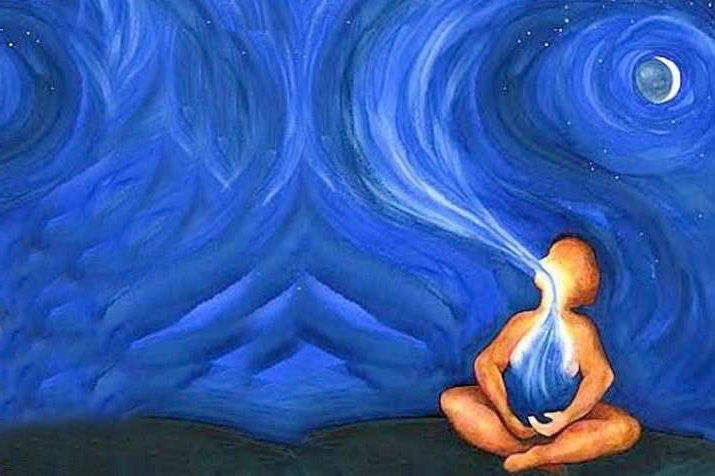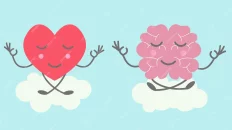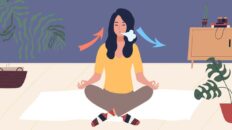Life begins with the very first breath we take and life ends with our final breath – the beginning and end of our journey on this earth.
There are many things we need to sustain life, but none as important as the breath.
The breath, how long can we live without it – a few minutes, less?
Well, brain damage begins after about 4 minutes and death about 4-6 minutes without oxygen, without the breath.
This process of breathing is so vitally important, but how often do we think about it?
We do it automatically, we take it for granted.
Do we ever stop and thank the breath for sustaining our life ??
Do we ever stop and think that maybe there is a force contained within the breath that we can harness for our greater good ??
There is much more to the breath than just the air we take in.
And this is what our topic is all about this evening.
Another tool in our toolbox to help increase the quality of our lives.
As I have stated many times, we are all made of energy, and this energy travels through our bodies in certain patterns.
When our energy is out of balance, our health is out of balance, our entire body is out of balance.
When this happens, our body is usually affected at our weakest area, at our weakest link, so to say.
One way we can bring the body back into balance is with the breath, with utilization of the breath.
You know, we can learn so much from those that went before us.
The Ancient Ones possessed remarkable powers of healing because they tapped into what they called “The Breath of Life”.
This is the spiritual life-force, an energy that gives our breath its life-sustaining powers.
Thousands of years ago, great Hindu Yogis & Chinese sages developed powerful systems of breath control. They used this for healing illness, mastering fear, and attaining enlightenment.
The spiritual life-force that dwells in our breath is not the same as the physical process of breathing or the air we take into our lungs.
Our breath is merely the vehicle through which this life-force manifests here in the physical world.
The Hindus call this life-force Prana.
The Chinese named it Chi.
The Hebrews call it the Breath of Life.
Christians call it the Holy Spirit.
No matter what name we give to this breath, it is intimately linked with our life-force.
It controls every mental and physical process that takes place within our being.
For example, all experiences of pain and fear are directly controlled by the breath.
Our breath contains some of the most powerful energies in the universe.
By mastering the forces that dwell in our breath, we can gain some of the most unique and remarkable powers for healing ourselves in body, mind and spirit.
Eastern martial artists have known this fact for thousands of years. They used this knowledge to develop highly sophisticated systems of breath control for cultivating the virtues of strength, courage and one-pointedness of mind so essential to being a warrior.
There are many different breathing techniques that, with practice, we can use to improve our health – physically, mentally, emotionally and spiritually.
Some of the techniques help us feel calm and solid.
Others help us feel more refreshed and energized.
Still others help reduce pain & fear, help relieve respiratory issues, alleviate symptoms of illness, plus much more.
One of the most important ingredients when working with the breath is mindfulness, to always be in the moment, be with what you are doing.
Buddha once said to his son, “Always practice mindfulness of breathing, for when this is maintained it brings great fruits and many blessings.”
The fruits and blessings you personally gain from working with these techniques will depend mostly on the strength of your commitment and the amount of quality time you spend in making this knowledge your own.
Let’s take a little break from all this information and practice a breathing technique that many of you may already know.
Squared Breathing
This is a technique that is calming and is very good for anxiety.
– Begin by slowly exhaling all of the air out of your lungs.
– Then, gently inhale through your nose to a slow count of 4.
– Hold at the top of the breath for a count of 4.
– Then gently exhale through your mouth for a count of 4.
– At the bottom of the breath, pause and hold for the count of 4.
Repeat for 4 or 5 rounds.
This Squared Breathing or Box Breathing, as it is also known, has been positively associated with better sleep, improved heart rate, mental clarity, improved brain function, anxiety & depression, panic attacks, plus a multitude of other issues.
4 Keys to Healthy Breathing
1.. Light Breathing 2.. Slow Breathing
3.. Nasal Breathing 4.. Belly Breathing
Now, when I tell you to begin, I want you all to just breathe, using your own pattern of breathing, whatever that is.
I am going to time you for one minute. Start now…….. Stop now.
Anyone want to share???
Optimal Breathing is about 12 breaths per minute, slow & easy. It is the secret key to getting the oxygen into the cells.
The red blood cells carry the oxygen throughout the body.
Carbon Dioxide (CO2) actually regulates your breathing.
CO2 is the doorway that lets the O2 get to all parts of your body.
Over breathing reduces the CO2 from doing its job.
Breathe through the nose. The mouth is for eating.
The nose acts as a filter.
The nose increases Nitric Oxide production.
Nitric oxide is released in the nasal passages during breathing.
Nasally derived NO has been shown to increase arterial oxygen tension and reduce pulmonary vascular resistance, thereby acting as an airborne messenger. In other word, breathing through the nose is good for the heart and lungs.
Again I say, breathing should be slow and unlaboured.
Slow and easy inhales with long, slow exhales.
Now, speaking of exhales, let’s do another breathing exercise.
This time I want you to:
Take in a nice long , slow, easy deep breath.
Then I want you to slowly exhale out all the air.
At the end of the exhale, hold your breath for as long as possible.
While you are holding your breath, count slowly.
See how long you can hold it for.
Then inhale. Anyone want to share?????
You should be able to hold it for at least a count of 25.
We can train our breath into a new, automatic, unconscious breathing pattern, thereby improving our overall health.
This will increase our energy and CO2 tolerance.
The perfect breath feels like we are not even breathing.
There is a very unique system in the brain that controls breathing.
It acts consciously and unconsciously.
The nervous system links the brain and the body.
When under stress, the breathing rate increases.
Stress is the number 1 contributor to disease.
We need to calm our mind, thereby calming and decreasing our breathing.
Now, for a little bit of trivia.
Have you ever wondered why people say “God bless you” when you sneeze?
This custom dates back to medieval times when people believed that the force of a sneeze temporarily separated the breath (and the spirit of life) from a person’s body. Our ancestors would quickly bless the sneezer to prevent evil spirits from entering and possessing the vacated body until the owner’s spirit (or soul) returned on the next in-breath.
The state of our physical, mental, and spiritual health depends on the health of the breath.
In other words, whatever is happening with our breathing is also happening at all other levels of our being.
This is because the breath controls every physical, mental and spiritual process that takes place within our system.
When our breathing is calm and peaceful, our mind and body are peaceful also.
When our breathing is agitated or disturbed for any reason, our mind and body feel scattered and disturbed.
So, by working with the breath, we can greatly contribute to our overall health.
The Five Stages of Perfecting the Breath
1.. Meditation on the breath is the first and most important technique to learn.
Meditation quiets the mind and guides it into a fearless, calm, detached state known as “witness consciousness”.
The witness is our inner self.
Just as Divine Prana is “the Breath of our breath”, the witness is “the Mind of our mind”.
Witness consciousness occurs naturally as we meditate.
As soon as we begin watching our breath, our mind begins to slow down, our body begins to relax, and all sense of effort starts menting away.
As our mind becomes increasingly peaceful, it shifts into neutral.
Entering into the witness state is fairly easy to do.
Once we are there, however, it is not so easy to stay there.
Edgar Allen Poe once wrote, “the witness belongs to the inner dimension of stillness”. It exists at the other end of your breath.
Meditating on the breath is the exercise we did at the beginning of this presentation.
The witness is just us watching the breath, watching as the breath comes in and out. We are the “Silent Witness”.
2.. Breathing-Release Techniques:
Once we have learned how to meditate, the next step is to move our breath out of its habitual ruts by working with breathing release techniques.
Releasing techniques expand and invigorate the flow of our breath by dispersing the fear-ridden blocks in our breathing. As our breath begins moving more freely, the increased flow of prana produces considerable amounts of spontaneous healing throughout our mind and body.
The purpose of these breathing-release techniques is to get rid of the blocks in our breathing that have become deep rooted habits.
(a) The Tarzan Technique:
Do you remember how Tarzan used to yell at the top of his lungs and beat on his chest with his fists?
He was actually imitating the battle cry of the African gorillas.
This gesture enables the gorillas to feel strong and centered in the face of danger.
It brings feelings of strength & power because it prevents the pectoral muscles from locking up in fear by promoting a strong outflow of breath.
This Tarzan Technique has a remarkable ability to disperse breathing blocks and bring immediate feelings of strength and confidence.
The Tarzan Exercise:
— Sit in a comfortable posture and focus your attention on the movements of your breath as the air moves in & out of the body.
We will take in 4 breaths….
Now, on the next breath, take in a little more air than usual.
As you exhale, make a strong, continuous “aaahhh” sound and beat on your chest with alternate fists as gorillas do.
Continue playing Tarzan for 3 more rounds….
Now, discontinue the technique and give your breath a chance to assimilate the invigorating waves of energy it releases.
As your breath readjusts, keep watching it and notice the changes that are now taking place in your breathing.
Notice how much faster your breathing is moving.
Notice how much freer and more open your breathing is.
Notice how much more alive you feel as the new waves of energy go coursing through your system.
Once your breath has restabilized (this usually takes about 30-45 seconds), you are ready to do another round of Tarzan.
Tarzan is a relatively forceful technique that is used to dislodge some of the grosser blocks in our breathing.
This technique fosters outgoing feelings of strength, courage and determination.
NOTE: Those that suffer from severe anxiety attacks or feelings of suffocation should avoid using this Tarzan technique and, instead work with Gentle Rapid Breathing Technique”.
(b) Gentle Rapid Breathing Technique:
This next releasing technique is based on an ancient yogic technique called Bastrikha, which means “bellows” in Sanskrit.
It is called the “bellows breath” because it is done by forcing air in and out of the lungs.
Some people call it “the breath of fire” because it is traditionally practiced with great force to “stroke” the purifying fires of yoga.
When Bastrikha is practiced less forcibly, it becomes an invaluable breathing-release technique called Gentle-Rapid Breathing.
This breathing technique disperses blocks and enlivens our breathing.
It is a much more refined technique than Tarzan breathing that enables us to disperse subtle tensions and energy blocks that Tarzan simply can’t reach.
This technique fosters subtler feelings of inner calm & strength.
Gentle Rapid Breathing Exercise:
– Think of how a dog cools itself on a hot day.
Pant gently, without forcing.
Make sure your in-breaths & out-breaths are reasonably even.
Now do the same thing, but this time close your mouth and pant through your nostrils.
– Now sit comfortably with good posture and begin to meditate on the breath.
– Once your mind is attuned to its movements, breathe gently and rapidly through your nostrils for about 5 or 10 seconds.
– When you discontinue the technique, keep watching your breath and study the changes it makes in your breathing.
– When you perform this gentle rapid breathing technique correctly, it brings feelings of aliveness that are relatively calm and quiet compared to the more intense, vigorous feelings that Tarzan produces.
– Once your breath has readjusted, you are ready to do another round.
– Each time you do this technique, try changing the speed with your breath. For example, try breathing a bit faster or a bit slower.
You can also experiment with the force and intensity of the breath.
– Once you have done three consecutive rounds, return to meditating on your breath until it feels like time to do another 3 rounds.
You can deepen your meditations, and speed your breath’s development by including both Tarzan and the Gentle Rapid Breathing technique as part of your daily practice.
You can begin your meditation session, then include three rounds of Tarzan followed by 3 rounds of gentle rapid breathing.
Then return to watching your breath without trying to influence its movements.
If your breathing becomes sluggish, just do a few rounds of gentle rapid breathing to wake it up again.
3. Grounding & Strengthening Techniques:
These techniques provide yet another set of tools for mastering fear.
As the words grounding & strengthening imply, these techniques help us feel more solid and strong in mind and body by deepening and strengthening our breathing.
(a) Solidifying The Breath Technique:
This technique is based on an ancient mudra (yogic hand position) that brings strength and groundness throughout the mind and body by deepening & strengthening our breathing.
Just as the power of an engine depends on the amount of compression it can build up in its cylinders, our feelings of strength and power similarly depend on the amount of compression with which we breathe – the depth and strength of our breathing.
Grounding Exercise #1 – Solidifying the Breath:
– Sit in a comfortable position and begin to meditate on the breath.
– Pay attention to how deep or shallow your breathing is, but don’t try to change it.
– Once you are in touch with the movement of the breath, make a fist with both of your hands by closing your fingers loosely over your thumbs.
– Then, still watching your breath, squeeze your thumbs with one steady pressure and hold it for a minute or so.
– As soon as you squeeze your thumbs, your breathing will become deeper & stronger.
– If you study the changes that take place in your feelings, you will discover that you feel more solid & grounded in both your mind and body.
– The harder you squeeze your thumbs, the deeper your breathing will become and the more solid & stronger you will feel at every level of being.
– Study these changes for another minute , then release your thumbs and allow your breathing to return to its original state.
– Once you have released the pressure on your thumbs, notice how relatively weak & shallow your “normal” way of breathing feels compared to the way it felt while you were squeezing your thumbs. Practicing this technique in conjunction with Tarzan and Gentle Rapid Breathing greatly multiplies its strengthening effects.
(b) Meditation on the Heartbeat Technique:
The rhythm of your heartbeat and the rhythm of your breath can function independently, or they can work in perfect synchronicity. When their rhythms become synchronized, your heart and breath both function at much higher levels of efficiency.
This next technique – meditation on the heartbeat – will teach you how to synchronize your heartbeat with the movements of your breath.
This strengthens every function of the heart and lungs.
It enhances the flow of prana moving through your system and brings new feelings of strength, peace, and wholeness throughout the mind and body.
People who suffer from panic attacks, shortness of breath, or heart-related problems, such as angina or erratic heartbeat will find this technique especially helpful for reducing their symptoms.
Grounding Exercise #2: Meditation on the Heartbeat.
– Close your eyes and begin to meditate on your breath.
– Once you have attuned to its movements, do a few rounds of Tarzan Breath and/or gentle rapid breathing to wake up your breathing.
– Once your breathing is open and flowing, focus your attention on your heartbeat without losing track of your breath.
– As you meditate on your breathing and your heartbeat at the very same time, their rhythms will gradually come into synch.
Don’t try to control their movements, they will synchronize themselves.
– As the rhythms of your breath & heart come into synch, new feelings of peace, wholeness, and inner well-being will gradually permeate your mind and body.
–The more often you work with this technique, the more your breathing and heartbeat will tend to stay in synch, even when you are not in meditation.
– XX Your breath and your heartbeat are the most powerful unifying forces in your body XX.
(c) Strengthening the Heart Technique:
To reach our highest potential, the compressive forces within our breath should always match the compressive forces within our heart, as it pumps the blood through our body.
When their compressions & timings are evenly matched, our breath & heart begin to function at their highest levels of efficiency and power.
Most of the time, the compressive forces within our hearts and those of the breath are poorly matched, and their rhythms are rarely in synch.
This next exercise – Strengthening the Heart – uses a combination of the solidifying technique and meditation on the heartbeat to produce greater feelings of wholeness and strength than we could possibly get by practicing either technique by itself.
Grounding Exercise: Strengthening the Heart.
– Sit in a comfortable meditative posture.
– Close your eyes and begin to meditate on the breath.
– Once you have attuned to its movement, meditate on the rhythms of your heartbeat & breath to bring them into synch.
– When the rhythms of your heart & breath have come into synch, squeeze your thumbs (or rubber balls) with one steady pressure to deepen & strengthen your breathing.
– Notice how this affects your heartbeat.
– Notice that as soon as you squeeze your thumbs (or rubber balls), your heartbeat becomes a bit stronger right along with the increased strength of your breathing.
– The next step is to give your heart a chance to absorb the new feelings of strength and support it is now receiving from your breath.
– Keep squeezing your thumbs with the same pressure and hold it steady for a minute or two while your heart accommodates its movements to the increased support it is now receiving from your breath.
– When you are ready to stop practicing this technique, be sure to release the pressure on your thumbs very gradually & gently.
– Gradually return to your basic breath meditation until you are ready to end the session.
NOTE: If you have a severe heart problem, be sure to work with only light to moderate pressure on your thumbs (or balls).
4. Breath Balancing Techniques:
Once we have learned to expand & deepen the flow of our breath, the next step is to improve the balance of tensions between our in-breaths & out-breaths.
We do this by correcting our habits of clutching, collapsing and pausing to block our feelings of fear. When the in-breaths & out-breaths become evenly matched, our feelings of anxiety, self-conflict and self-doubt begin to fade and disappear.
These techniques will not only control our mood swings; they will increase the volume of air that enters the lungs and enhance the flow of prana to every part of your mind and body.
Those suffering from chronic breathing disorders can also find these techniques helpful by helping disperse the blocks in their breathing. This, thereby reduces the feelings of anxiety that usually accompany shortness of breath.
Breath Balancing Exercise #1: Gentling The In-Breath.
– Sit in a comfortable meditative posture.
– Begin to meditate on the breath.
– Without trying to change it, become aware of the volume of air that enters your lungs.
– Next, when you inhale, imagine you are breathing the air into your body (as if) from up between your legs. (visualization)
As soon as you do this, the amount of air that enters your body will noticeably increase.
– This increase in the volume of air is a sign that the tensions of your in-breath have begun to relax and your habit of clutching is already becoming weaker.
You will also feel more calm & relaxed in mind and body.
– Continue this technique for the remainder of the session.
Breath-Balancing Technique #2: Correcting The Pause.
The next step in balancing the tensions of our in-breath and our out-breath is to correct the habit of lingering in the pause that occurs at the end of each our-breath.
The natural pause should last no longer than about a split second and each should be of equal duration.
This lingering in the pause is a passive form of blocking.
It not only brings illusionary feelings of comfort & safety, it is also dangerous to our mental health.
Lingering in the pause is not only where our mind goes to hide from unwanted thoughts & feelings, but it is also the dimension of consciousness in which all forms of mental dissociation are born.
This is the dimension of consciousness where hallucinations can take place.
This next technique, “correcting the pause”, will enable you to weaken the habit of pausing & lingering at the end of the out-breath.
This means that you will not only stop “spacing out” to escape difficult thoughts & feelings, you will also have fewer experiences of helplessness & depression in both your dreams and in your everyday state of waking consciousness.
Breath Balancing Exercise #2: Correcting the Pause
– Sit in a comfortable position. Meditate on the Breath.
– Once you are in touch with its movement, become aware of the volume of air that enters your body each time you breathe in.
Do not try to change it.
– Next, when you inhale, imagine that you are bringing the air up into your body from between your legs.
– When you exhale, do not allow your breath to linger before you breathe back in.
When you reach the bottom of each exhalation, remind the breath to come back into your body, breathing in (as if) from up between your legs.
– Be vigilant for the remainder of the practice session, don’t allow the breath to pause & linger at the end of the out-breath.
Breath Balancing Technique #3: Strengthening the Out-Breath.
The out-breath represents the “masculine” or active aspect of our being.
It is sometimes called the “manifesting breath”, because breathing out is the basis of every action we take in life.
When our breathing patterns are well-developed, the tensions of our in-breath and our out-breath are evenly matched.
This next technique, “strengthening the out breath”, will enable you to strengthen your exhalations and weaken the habit of collapsing as you breathe out.
Breathing Balance Exercise #3: Strengthening the Out-Breath.
– Sit in a comfortable position. – Meditate on the Breath..
– Do a few rounds of Tarzan and/or gentle rapid breathing to invigorate the flow of your breathing.
– As soon as your breath is more open & flowing, begin gentling your in-breath by breathing the air up into your body as if from between your legs.
– Now, at the end of each exhalation, thrust the air from your body by contracting your diaphragm with a moderate degree of force.
–As soon as you thrust at the end of the out-breath, the air will come right back into your body with new feelings of vigor and strength.
– As your breath readjusts its tensions, you will find that your breath is moving with greater freedom and ease.
– You will also find that you are feeling more calm & solid throughout your mind & body.
Perfecting The Balance of Tensions
Perfecting the Tensions in our in-breath & out-breath is not a straight line process.
It cannot be completed in weeks, months, or frequently even years of continuous practice.
It is a gradual & long term process that involves many emotional ups & downs, because the tensions of our in- and out-breaths are continually changing with every shift in our emotions.
More than a thousand years ago a Taoist Master wrote:
It is within the nature of common man’s breathing to have difficulty retaining the inhalation, while the exhalation is easily exhausted.
5. Breath – Retention Techniques:
Once our breathing patterns have become freer, stronger, and more evenly balanced, we are ready to work with breathing retention techniques.
These techniques enable us to suspend the movements of our breath for extended periods of time.
By using this technique, we can accumulate greater inner reserves of spiritual strength & power.
The main purpose of retention techniques, however, is to attain the deepest level of meditative consciousness our mind can possibly enter.
Within this state, tremendous spontaneous healing can take place throughout our mind & body.
These are on a much higher level & will be discussed later.





Add comment